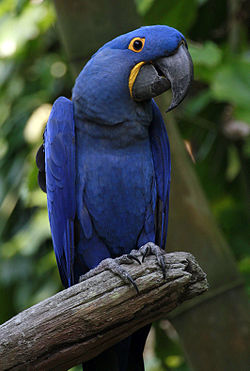Smuggling
Shortly after Silva started selling birds, he is believed to have begun supplementing his own birds with birds obtained on the black market, before eventually moving into smuggling. [13] Between at least 1986 and 1991, Silva conspired to smuggle protected birds valued at more than $1.3 million into the United States, neglecting to declare this income on his taxes. [14] [15] [16] While he was working at Loro Parque, Silva's mother ran the smuggling operation on his behalf. [14] [15]
Birds were provided by co-conspirators in South America and shipped to Argentina or Mexico before being offloaded and smuggled into the United States. [17] [18] Smuggled birds were often concealed by mixing them into a shipment of legally imported birds; Silva and his accomplices sneaked out the smuggled birds while the shipment was awaiting quarantine inspection. [14] Other birds were smuggled in plastic tubes, cardboard containers, and false-bottomed suitcases. [14] [16] [19] Many died during transport due to lack of food, water, and fresh air, and many more are thought to have died during capture. [2] [19] [20] Birds were transported to a Chicago-area motel room where they were surgically sexed and furnished with forged documents so they could be sold on the legal market. [10] Some of the birds were publicly advertised for sale in American Cage-bird Magazine. [10] [21]
Operation Renegade

In 1989, Silva became a person of interest in an international probe into bird smuggling known as "Operation Renegade" led by the U.S. Fish and Wildlife Service (USFWS). [16] Silva had been brought to the attention of authorities when convicted drug lord Mario Tabraue turned informant, claiming that he had received a shipment of 35 smuggled hyacinth macaws from Silva—which arrived sick and died soon thereafter. [16] [5] [19] In early 1990, Silva's friend Jim Mackman approached authorities after discovering that Silva had been smuggling protected birds. [14] Between 1990 and 1992, Mackman worked as an undercover informant for USFWS, secretly recording more than 100 conversations with Silva and his mother about their smuggling operation. [14] A search warrant executed on 16 January 1992 resulted in the seizure of 103 parrots, some or all of which were protected or illegally imported. [23] The search also revealed ledgers documenting illegal transactions and photographs of birds that had died en route to Silva; prosecutors alleged that Silva used these photographs to justify withholding payments to his supplier. [19] [24]
Between November 1994 and April 1995, Silva was indicted on 20 charges, including charges of conspiracy to commit wildlife smuggling, as well as charges of tax evasion and perjury. [25] [26] [27] Silva was charged with smuggling at least 186 hyacinth macaws into the United States; [17] this comprised 5–10% of the global population. [28] Silva was also charged with illegally trafficking, transporting, or possessing a number of other birds such as crimson-bellied conures, Queen of Bavaria conures, vinaceous amazons, cockatoos, flamingos, and toco toucans. [17] [24] [28] He was suspected of having smuggled Spix's macaws, but this could not be proven. [10]
On 30 January 1996, Silva pleaded guilty as part of a plea bargain to one count of conspiracy to violate wildlife and customs laws and one count of filing a false income tax return. [15] [22] He later attempted to reverse his guilty plea, [29] but this was not permitted by the court. [30] [31] On 18 November 1996, Silva was convicted of smuggling more than 450 protected birds and seven monkeys into the United States. [32] He was sentenced to 82 months in prison, fined $100,000, and ordered to perform 200 hours of community service during a three-year probationary term after his prison sentence. [28] [1] [16] At the time, this was the severest-ever sentence for bird smuggling in the United States, imposed by the judge because of "great cruelty" inflicted upon the birds. [28] [19]
Silva was incarcerated at FPC Duluth. [33] Appeals of his conviction were unsuccessful, [18] [34] as was an attempt to sue the U.S. government for the value of the parrots confiscated during the 1992 search. [23] Silva was released in May 2002. [35]